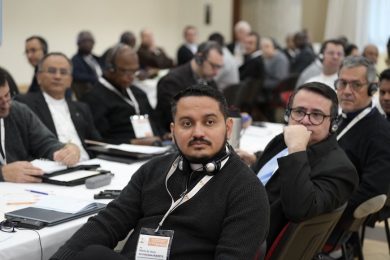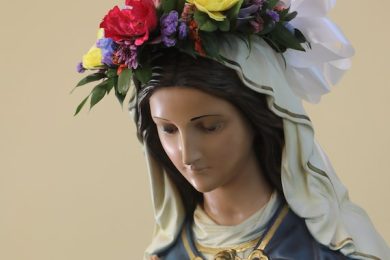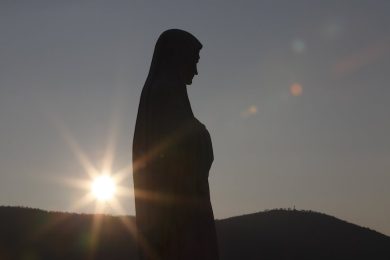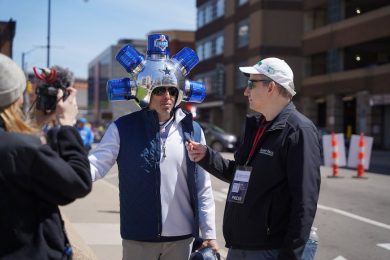On Oct. 17, the Benedictine monks of Saint John’s Abbey will officially dedicate a brand new 30,000 square foot woodworking shop, which also will be home to Abbey Organ Builders, an organ building program inspired during a visit from organ builder Martin Pasi in 2019 while completing an expansion of the abbey church’s organ.
Q: How does woodworking fit into the Abbey’s mission and charisms?
Father Lew: “Ora et Labora” — which means “Pray and Work” — has become the motto for Benedictine monasticism. Understandably, prayer is at the center of our life as monks, but alongside this dedication to prayer St. Benedict holds up work as a valuable and necessary activity for monks — especially manual labor. For Benedict, work was not only the way to support the community and keep monks from being idle but was also a “friend of the soul.” It is a practical way to give expression to our God-given talents and abilities in service to the community.

No matter their background, St. Benedict required each monk to spend a good chunk of their day occupied with manual labor. While much of our community’s work has moved away from manual labor, woodworking helps keeps us connected to Benedict’s call to work with our hands and allows us to witness to the dignity of manual labor to our students, guests and the wider world. The woodshop is a place where each discerning candidate to the monastery learns the value of manual labor.
As an abbey, we are blessed with an abundance of natural resources and woodworking is one way that we can be good stewards of God’s creation and goods. We sustainably harvest lumber from our own forests, utilize local craftsmen and most of the products stay in the local community. The fact that furniture we built over 90 years ago is still in daily use is a testament to the craftsmanship and durability of our products. We build things to last in hopes of being stewards of the resources we’ve been given.
Finally, since our founding in 1856, the monks of Saint John’s Abbey have given expression to a strong entrepreneurial spirit. You see this in the founding of Saint John’s Preparatory School, University, Liturgical Press, Boys’ Choir, Abbey Arboretum, Collegeville Institute, Minnesota Public Radio, Hill Museum and Monastic Library, Abbey Guesthouse and the Saint John’s Bible. The community is willing to run with a good idea and support it in service to the local and wider Church and community. This new venture is a continuation of this tradition.
Q: What is your role there? What led you into this form of ministry?
Father Lew: For the past four years, I’ve been director of Saint John’s Abbey Woodworking. Like most vocations, the path to my current ministry was not direct. As with any newcomer to monastic life, my work during novitiate entailed manual labor (cleaning, gardening, woodworking, etc.). I loved this balance between manual labor, study and prayer. As I started seminary, I found myself missing the opportunity to work with my hands. So, my formation director allowed me to pick up a few hours a week in the Abbey Woodshop. The more I worked in the woodshop, the more I discerned that woodworking was a trade that I was attracted to, that I felt gifted for and through which I believed I could serve the community. I feel blessed that the community has supported me in this call.
Q: Tell us a little about your team — who it involves, what your main focus/foci are.
Father Lew: Our team is made up of monks, local lay craftsmen, students and volunteers. For the past 165 years, these woodworkers have provided much of the furniture and millwork for the Saint John’s campus. While most of what we craft in the woodshop stays on campus, we also make pieces that are destined for life outside of Saint John’s. This includes stands and cabinets for the Saint John’s Bible, custom furniture of all sorts, the Saint John’s cross, caskets and urns, and various pieces for churches. In the last few weeks, we’ve delivered Bible cabinets to the National Cathedral in Washington, D.C., and Lambeth Palace in London, outfitted a chapel with furniture for the sisters in Atchison, Kansas, installed a new bar top for Brother Willie’s Pub, and built a 40-foot display case for a letterpress scroll of the Rule of Saint Benedict that is currently traveling the country.
Q: Is there a theology behind what happens in the woodshop?
Father Lew: If you look out the front door of the current woodshop, you’ll see the letters IOGD emblazoned on the side of the Quadrangle. This acronym stands for “In Omnibus Glorificetur Deus,” that in all things God may be glorified. Our woodshop has been blessed with natural resources and coworkers blessed with many talents and abilities. This motto gives us meaning for what we do. It inspires us to give thanks and know that what we do has a purpose. More than crafting a chair or pipe, our work is giving glory to God through the way we use the resources and talents we’ve been given. It is our hope that those who use our furniture or hear our pipe organs will be reminded of this, “that in all things God may be glorified.”

Q: Tell us a little about why Saint John’s Abbey Wood-working decided to partner with Pasi Organ Builders.
Father Lew: For the past 35 years, Martin Pasi and his team of organ builders have built world-class pipe organs in an old-world style — one at a time, every part by hand. Martin had long dreamed of creating a workshop that would pass on this tradition to the next generation of organ builders. As he was installing the expanded Holtkamp-Pasi organ in the Abbey and University Church in 2019, he heard of our desire to build a new woodshop and approached us with his vision. At first it sounded like nothing more than a “pipe dream,” but as the idea developed, we started to see it as a once in a lifetime opportunity.
First, organ building has deep roots in the Benedictine tradition. Organs have not only accompanied our daily prayer for centuries, but Benedictines have influenced generations of organ builders throughout Europe. The most famous of these, Benedictine Dom Bédos De Celles (1709-1779), a monk whose monumental treatise, “The Art of Organ Building,” remains the most important compendium of traditional organ building methods today.
Second, woodworking and pipe organ building have many similarities. Therefore, much of the space and equipment will be shared between the two operations. Also, woodworkers and organ builders will build a symbiotic relationship between themselves in that they will assist and help bring one another to a new level.
Third, we hope to be able to give witness to the university and preparatory school students on our campus that a vocation involving skilled manual labor is respected, rewarding and fulfilling.
Q: What is the Work of Our Hands Project? How can people get involved?
Father Lew: The Work of Our Hands is a significant capital endeavor for Saint John’s Abbey. The new 30,000-square-foot Abbey Woodshop will centralize woodworking operations and house the organ-building program. The two-story facility will add instruction space, increase efficiency and production, provide a safer work environment and renew our commitment to the monastic tradition of manual labor. Once completed, this building looks to firmly establish Saint John’s Abbey Woodworking and Organ Builders as a premier workshop for quality handwork, where artisans, grounded in and inspired by Benedictine values, create pieces of beauty and utility and nurture their craft for generations to come.
The response to this project has been overwhelming. Over 2,200 donations have been received in support of the project. The donations have come from people who are interested in manual labor, pipe organs, woodworking or simply hoping to pass on manual trades to the next generation. We are close to our goal, but not quite yet there. If people wish to support this project, please reach out via the contact info at our website: https://saintjohnsabbey.org/work-of-our-hands.
Q: What impact does the new space have on the wider community?
Father Lew: Beyond a facility that produces furniture and pipe organs, we look to educate future artisans in these trades. In collaboration with our schools, we will continue to have student workers and plan to build an apprenticeship program to teach these skills to the next generation. Also, we hope to provide internships and classes for liturgical musicians on the maintenance and tuning of organs. As a diocese blessed with many fine organs, we want to educate musicians on how to take care of their organs so that these instruments can continue to bless our worship. Alongside this educational piece, we look to provide organ maintenance service to local churches who may need help with their instrument. Finally, we hope it will be an inviting place for those interested in woodworking and pipe organ building. Once we are established, the new facility will have space to offer activities for the wider community. We are very excited about this possibility.
\\\\\\\\\\\\\\\\\\\\\\\\\\\\\\\\\\\\
Saint John’s Abbey blessing and dedication of the new Abbey Woodshop:
Tuesday, October 17, 20234:00 PM Blessing and DedicationAbbey Woodshop
2825 Powerhouse RoadCollegeville, MN 56321





















